6-13 August 2013. Our first day in Mexico City and we went wandering to the Zócolo which was full of not very inviting huge white tents, with childrens’ blow-up play castles outside – all fenced off. We weren’t drawn to investigate. We were on our way to some unearthed Aztec ruins right in the downtown core. What we found on the way, right next to the Zócolo, was by far the most interesting thing of the day. It seems that it was “shaman day” downtown. Even though we passed by this way on several other occasions we never saw them again. Agape we were! Astonished! A completely unexpected spectacular spectacle!

There were several of them, most giving short shamanic “treatments” to the many people lined up. Mexico may be a Catholic country, courtesy of the Spanish, but obviously the old traditions run deep. We also lined up. We were kind of growled and grunted at, and water splashed on us with leaves, and smoke waved all around us. See, I can feel the energy of this kind of thing, having been open to spiritual energies all my adult life. I was squealing with excitement. Don thought he did some energetic thing to do with strengthening the bond between us – as if that was needed. Anyway it was fun. And joyful.
This is our guy

Templo Mayor
Apparently electricians were digging and found some Aztec stone sculptures. As a result the Mexican government had the buildings of a whole city block torn down to excavate the area. The result was the discovery of Templo Mayor, an Aztec temple to both the god of war, (with the unpronounceable name of Huitzilopochtli) and Tlaloc, the god of rain.
This god of the dead and king of the lowest section of the underworld (his name is also unpronounceable – Mictlantecuhtli), was one of many sculptures and offerings found. He was one of the main gods of the Aztecs and worship of him sometimes involved cannibalism. Bloody lot, those Aztecs.
We also saw this guy who looks a bit startled. He’s a chacmool and was associated with the rain god, or he is destined for sacrifice to the rain god. Enough to make anyone look startled.
and a wall of stone skulls
The Aztecs sacrificed the skulls or hearts of warriors to the god of war, and at Templo Mayor archaeologists found a rare child sacrifice. Altogether a heart-warming visit.
Museo de Arte Popular
There’s a museum of Mexican folk art that really is heart-warming, delightful, joyful. Here are a few of the pieces that caught my eye: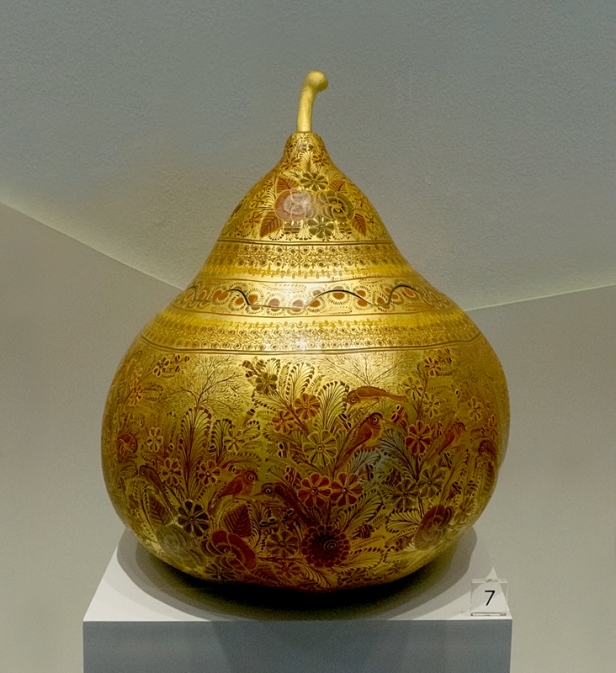
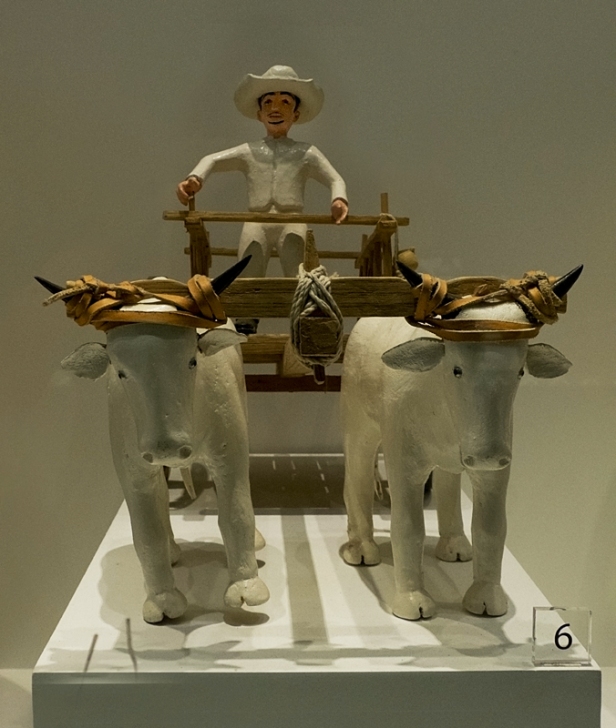

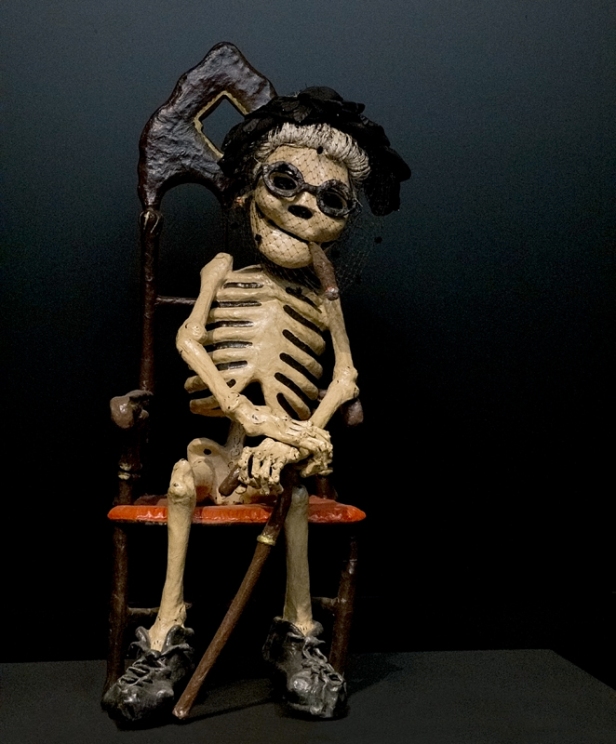

I met a man in Santa Maria Del Tule, a Mexican who used to work for Interpol, but with the advent in his life of a wife and children he switched to the safer occupation of English teacher. He said to not go anywhere in Mexico City where there was not a strong police presence. But how would we know until we got there? We wanted to go to Xochimilco, and to Frida Khalo’s house, both way out in the suburbs. We went anyway. To get to Xochimilco we negotiated for the first time the Mexico City metro, to the end of the line, and then a tram ride, and then a fifteen-minute walk. Every step of the way people were helpful and friendly, and we didn’t ever feel remotely unsafe. On the way back, on the train, a young boy (about ten years old) sitting next to Don, began talking to us in Spanish. What a sweet conversation we had. We knew enough Spanish to understand him, and he taught us more, and we taught him some English. His mother and older sister, sitting opposite, and others nearby watching us, were smiling the whole time. It was a wonderfully open and innocent exchange; he was so present and full of curiosity and joy. It’s a great example of why we love to travel by public transport, and was followed, when we got off the train, by another brief sweet conversation with a woman who had witnessed our exchange with the boy. As we left the subway we noticed a man in a wheelchair at the bottom of the crowded stairs. Quick as a flash four men stepped in, lifted the wheelchair, and carried him to the top. Everywhere we go we see examples like this of the good-heartedness of people.
Xochimilco is known for its canals left from an extensive lake and canal system that once connected most of the villages of the Valley of Mexico. If I were to return I would walk right by the brightly coloured tourist boats and convince someone with a small boat to take me exploring on the many small side canals where people still live by agriculture on man-made islands.
But we knew none of this (our mistake for not doing our research ahead of time) and the path from the tram to the party boats was so obvious, and the many boat owners wanting to take us for a ride so persistent, that we chose one and went for a ride. And what a ride! Down a kind of “Grand Canal” crowded with boats being poled along, and filled with Mexicans on holiday. Almost every boat was full, everyone drinking and eating as they floated down the canal. Sometimes there were two boats tied together with twenty or thirty people on board along with their own Mariachi band. One paired set of boats was obviously the venue for an engagement or wedding party. Smaller boats selling food, or flowers, or dolls, or plants, or serapes, or a Mariachi band wanting to serenade any boat going by. Many Mariachi bands! The boats so close they were often in competition with one another. It was floating bedlam in the best way. I don’t think we saw the real Xochimilco, but we sure had a good time.


On the way home we ran into Edward Scissorhands working his magic
The streets of Mexico City
Men at work
Best Prom dress ever!
Street performer taking a break
Outside Frida Khalo’s house
The ancient City of Teotihuacan
From as long ago as 150 BC twenty to thirty thousand people lived in this Mesoamerican city. By 350 AD the population had grown to over ninety thousand, and the temples of the Sun and the Moon, and most of the apartment compounds had been built. Teotihuacans, their goods, symbols and artistic style had spread throughout Mesoamerica. Centuries later Aztecs from other areas made pilgrimages here. At the height of its grandeur it was a city of over one hundred thousand. Who built the great city of Teotihuacan? Apparently its origins are still a mystery. There is so much scholarly history of the many different peoples that lived both in Teotihuacan and in other parts of Mesoamerica that I feel I’m kind of drowning in it. Enough to say we were awed by the sheer size, complexity and perfection of construction of a city thousands of years old.
Pyramid of the Sun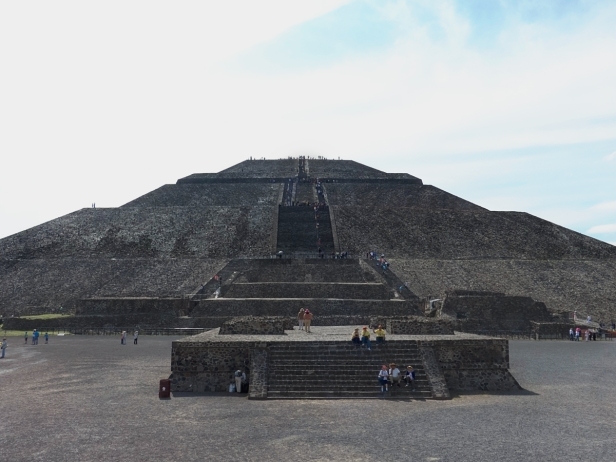
Pyramid of the moon

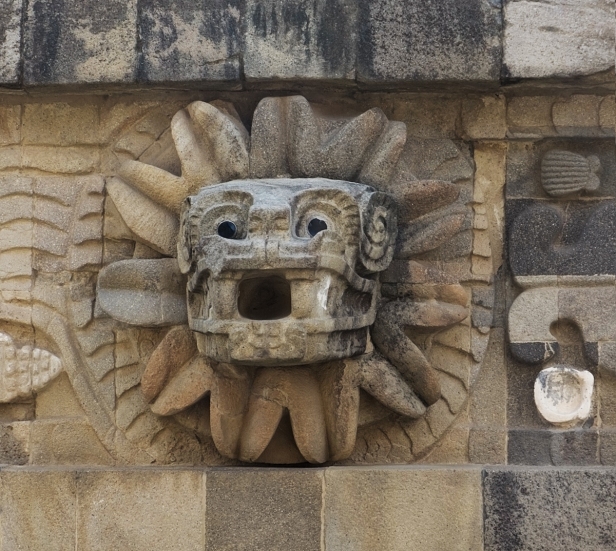
In the museum

Taking a break
Mexico gets a bad rap in the U.S. media and government websites, mainly because of illegal immigrants and the drug gangs in the border states. People are warned the country is dangerous, and there is perhaps some truth to this in the border states. Throughout Canada and the U.S. Mexico is also known as an inexpensive holiday destination to beautiful beaches at such places as Los Cabos and Puerto Vallarta which are completely subsumed by the Gringo tourist culture. Mexicans have a reputation for being laid back, for always putting things off until mañana, and for being somewhat “less than” their northern neighbours. I’m not saying all people from the U.S. and Canada perceive them this way, but it’s a fairly pervasive characterization.
This is not the Mexico we experienced. Far from it. For a start we didn’t go near Puerto Vallarta (beyond arriving at the airport there and immediately heading out of town), and years ago spending one day in Cabo was enough. The Mexico we found was warm, hospitable, friendly, kind-hearted and industrious. In the places we visited we found a people rightly proud of their rich heritage and their country, who welcomed us with open arms, and who delighted in sharing their culture. We’re so glad we went there.
This is the final post about our time in Mexico. Next post – a little about family visits in Sweden and Montreal, and then Argentina!
All words and images by Alison Louise Armstrong unless otherwise noted.
© Alison Louise Armstrong and Adventures in Wonderland – a pilgrimage of the heart, 2010-2015.

Loved the story of the boy on the train! Wonderful pictures and post, as always.
LikeLike
Thanks Michelle. It was such a delight when that child began speaking to us. *And* that we knew enough Spanish to understand him and thus be able to have a conversation.
LikeLike
I echo Michelle’s sentiments — I loved the story of the boy on the train! And your vivid photography is absolutely engaging.
LikeLike
Thanks Laurie. The boy on the train was certainly one of the special moments in our travels. He was so open and fresh and curious. Just a complete delight.
LikeLike
Fab photos and wonderful post as usual. Most engaging for the reader~
LikeLike
Thanks Cindy. I like that word engaging :), it’s very encouraging. Thanks.
LikeLike
Canadian media can be pretty harsh about Mexico being a dangerous place to visit. Mexico has never been a place that has been a draw for me though but not because of what’s been reported in the news. I have a few friends that have been and really loved it, some to resorts and some not. What a nice surprise happening upon Shaman Day, that first photo is spectacular.
LikeLike
I didn’t know about the Canadian media coverage 0f Mexico, even though I live there. I try to avoid watching the news. Good to hear your friends liked Mexico. It’s not a total paradise, but then what place is? Our experience was that people were helpful and friendly, and the culture fabulous. I don’t think there’s an official Shaman Day – or not that I know of anyway. I just called it that. We went back there wanting to see them again but never saw them after that first time. It was a Wednesday – maybe they’re there every Wednesday.
Thanks for your nice comment on the photo.
LikeLike
You’ve almost made me want to visit Mexico, which I have never wanted to do. Great photos as usual. thanks
LikeLike
Thanks Sueann. Go visit Mexico! It’s better than you think 🙂
I think you just have to pick and choose where you go. It’s not like the whole country is a pack of criminals. Like anywhere most people are just trying to live their lives, and they have such a rich culture. Especially the festivals.
LikeLike
Your pictures and commentary are fabulous. I think all this needs to be published in one big incredible travel book someday. xxoo
LikeLike
Thank you! Oh I would love it all to become one big incredible travel book, or the best parts of it anyway. One day . . . . . .
xox
LikeLike
Great post, Alison. I would so love to have a visit with a Mexican shaman! The spiritual energy would be an incredible experience I would think.
LikeLike
Thanks Angeline. Even the brief time we spent with the shaman felt really powerful. I’m so glad we ran into them.
LikeLike
I always have the feeling I am traveling with you every time I read your fabulous adventures Alison Thank you xo.
LikeLike
Thank you so much Anyes. It’s a lovely compliment for me, and very encouraging.
xox
LikeLike
Love the photos! I recognize those pyramids from a Gowan video in the 1980s….(I guess I need to get out more 🙂 )
LikeLike
Thanks Fiona. Aren’t those pyramids amazing?! We climbed two of the three (there’s a smaller citadel pyramid that’s not shown). Took us about half an hour in the heat to climb the biggest – Temple of the Sun, but really worth it. Plus walked about 3km around the site – it’s huge.
LikeLike
I see Chacmool has his container ready for the warm heart of a sacrificed virgin. 🙂 As for the Shaman, they are wonderful. I am reminded of an encounter with Bear, a seven foot shaman from Nevada City, California, who carried a 6 foot large tuning fork and gave me a tune up. Great blog, as always. –Curt
LikeLike
Chacmool’s container is almost certainly for a warm heart, but it may well be his own 🙂
Bear sounds . . . . um . . . . .interesting
Gave us both a good laugh anyway 🙂
Was it a good tune up?
LikeLike
The tune up was fine. I vibrated. I drew the line when Bear wanted to suck the evil beings out of my body. He made quite the noise when he went after a friend’s neck and it was my hip that hurt. –Curt
LikeLike
LOLOLOLOL!
LikeLike
I love living vicariously through your travels in Mexico. I’m listening to a Great Courses lecture about the lost civilizations of South America, so I’m particularly delighted by your photographs from Teotihuacan.
LikeLike
Thanks Felicity, so glad to hear your enjoying it. Isn’t Teotohuacan Amazing?! We loved it! Loved everywhere we went in Mexico.
LikeLike
Thanks for the memories, Alison. Mexico City ranks high on our favorites. You already mentioned many of the reasons why. I recall the wonderful Frida Kahlo museum as well as the two connected houses where she and Diego lived side by side for a while. So many fascinating things to see. I was also in awe about the many bookstores stuffed to the rafters. We will be back for sure.
LikeLike
Thanks Helga, and you’re welcome. We enjoyed Mexico City. We enjoyed Mexico! It was so much better than we ever thought it would be. All of it. I imagine we too will go back. It is a country far richer in spirit than most of the rest of North America realizes.
LikeLike
thank you so much for the link. my internet (claro) rolled over and died last week so i am way behind now that i’m in town for an hour or so… i will save this and appreciate every image when i am home and unhurried. this is a wonderful post!
LikeLike
Thank you so much Lisa. Hope your internet is up and going again soon!
Alison
LikeLike
Nice blog. You helped me explore more about Mexico and learn more of my culture. Thanks
LikeLiked by 1 person
Thanks so much Humberto. Our current visit is our fourth to Mexico. We really enjoy your country and learn more about the rich heritage every time we visit.
Alison
LikeLike